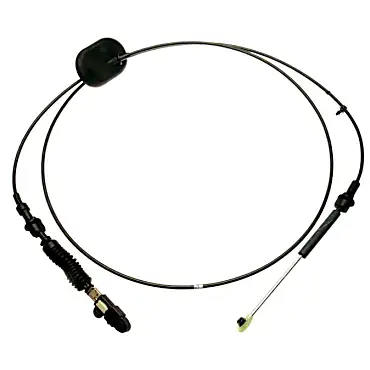Answers

Oct 09, 2023 - 08:38 PM
Hi there,
It is best to have a repair shop run a diagnostic and generate a trouble code to isolate the problem part. There are possible causes for the issue you are encountering. Check the following details:
1. A defective shift interlock solenoid. It is the part that prevents the shifter from being moved out of park unless the brake pedal is depressed.
2. A faulty transmission linkage or cable. The linkage can prevent the shifter to go to park in cold weather conditions.
3. A defective transmission control module. It is the main computer that controls the transmission. A bad TCM can cause a variety of problems with the transmission, such as the shifter going to "park" mode.
I hope this helps!

Oct 17, 2023 - 01:09 PM
The behavior you're describing in your 1990 Ford Taurus station wagon, where the shifter behaves differently based on the outside temperature, is indicative of a component being affected by the cold. Here are some possible explanations and potential solutions:
Shift Cable Binding: The shift cable that connects the shifter to the transmission might be old and starting to bind. Cables can get moisture inside, which may freeze or become more viscous in cold temperatures, making the cable stiff.
Solution: You might need to replace the shift cable or, in some cases, lubricate it if it's serviceable (although replacement is often the better long-term fix).
Shifter Assembly Issues: There might be parts within the shifter assembly that become tight or stiff with lower temperatures. This could be due to old lubrication or worn components.
Solution: Inspect the shifter assembly for any visible issues. Cleaning and applying fresh lubrication might help, but if there's significant wear, you might consider replacing parts of the assembly.
Transmission Fluid Viscosity: Transmission fluid thickens as temperatures drop, and if your transmission fluid is old or contaminated, it might be causing some resistance. However, this is less likely to affect the shifter and more likely to affect transmission performance.
Solution: Check the transmission fluid level and its condition. If it's dark or has a burnt smell, consider a transmission fluid change.
Mechanical Linkages: Over time, mechanical linkages can become stiff, especially if they're exposed to the elements. Cold temperatures can exacerbate this stiffness.
Solution: Inspect and lubricate the external linkages and pivot points.
Temperature-Related Contraction: Materials expand and contract with temperature. There's a possibility that some parts are contracting in a way that affects the shifter's operation.
Solution: This would be harder to pinpoint without careful inspection, but ensuring all components are in good condition and properly lubricated can help.
Shift Interlock System: Some vehicles have a system that prevents the shifter from moving out of 'Park' unless the brake pedal is depressed. If this system malfunctions due to cold temperatures, it might be causing your issue. However, it seems less likely in your case since the issue is with getting the car into Park, not out of it.
Given the age of the vehicle, wear and tear on the components involved in shifting is expected. It might be a good idea to have a mechanic inspect the shift cable, the shifter assembly, and related components, especially if you're unfamiliar with these systems. Ensuring proper operation is crucial for safety, as you wouldn't want the car to roll away unexpectedly if it's not fully engaged in 'Park'.
Shift Cable Binding: The shift cable that connects the shifter to the transmission might be old and starting to bind. Cables can get moisture inside, which may freeze or become more viscous in cold temperatures, making the cable stiff.
Solution: You might need to replace the shift cable or, in some cases, lubricate it if it's serviceable (although replacement is often the better long-term fix).
Shifter Assembly Issues: There might be parts within the shifter assembly that become tight or stiff with lower temperatures. This could be due to old lubrication or worn components.
Solution: Inspect the shifter assembly for any visible issues. Cleaning and applying fresh lubrication might help, but if there's significant wear, you might consider replacing parts of the assembly.
Transmission Fluid Viscosity: Transmission fluid thickens as temperatures drop, and if your transmission fluid is old or contaminated, it might be causing some resistance. However, this is less likely to affect the shifter and more likely to affect transmission performance.
Solution: Check the transmission fluid level and its condition. If it's dark or has a burnt smell, consider a transmission fluid change.
Mechanical Linkages: Over time, mechanical linkages can become stiff, especially if they're exposed to the elements. Cold temperatures can exacerbate this stiffness.
Solution: Inspect and lubricate the external linkages and pivot points.
Temperature-Related Contraction: Materials expand and contract with temperature. There's a possibility that some parts are contracting in a way that affects the shifter's operation.
Solution: This would be harder to pinpoint without careful inspection, but ensuring all components are in good condition and properly lubricated can help.
Shift Interlock System: Some vehicles have a system that prevents the shifter from moving out of 'Park' unless the brake pedal is depressed. If this system malfunctions due to cold temperatures, it might be causing your issue. However, it seems less likely in your case since the issue is with getting the car into Park, not out of it.
Given the age of the vehicle, wear and tear on the components involved in shifting is expected. It might be a good idea to have a mechanic inspect the shift cable, the shifter assembly, and related components, especially if you're unfamiliar with these systems. Ensuring proper operation is crucial for safety, as you wouldn't want the car to roll away unexpectedly if it's not fully engaged in 'Park'.







Add New Comment